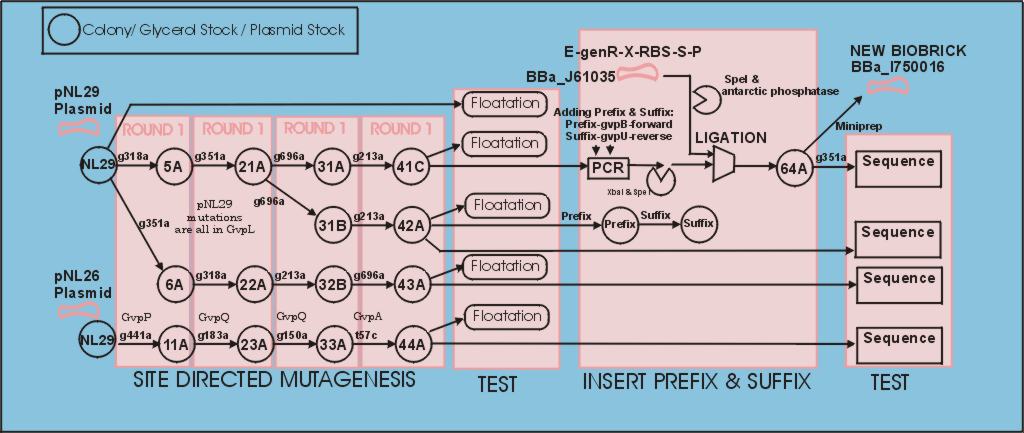Melbourne/Lab GV Notebook
From 2007.igem.org
| Line 9: | Line 9: | ||
Following the successfull ligation the part was sequenced. In the process we discovered that the 43bp primer used for mutation gvpL(g696a) had self annealed in some way to induce ten repeats of a 40bp sequence.(31A). | Following the successfull ligation the part was sequenced. In the process we discovered that the 43bp primer used for mutation gvpL(g696a) had self annealed in some way to induce ten repeats of a 40bp sequence.(31A). | ||
| + | Interestingly although this introduces a frame shift about 30 amino acids short of the end of GvpL, it does not seem to effect the bouyancy phenotype. The part was documented and shipped as a functional biobrick. | ||
| + | |||
| + | Throughout the process independent parrellel mutation sequences were performed to ensure not single random event could stop the development. (43A) has no g696a induced repeat but the ligation has not been performed on these other parts because of time limmitations resulting from the original ligation failure. | ||
| + | In the first mutation test all primer pairs were tested to ensure they functioned, this saved us a week since only a handfull worked without changing the PCR conditions. at the end and as it turns out | ||
| + | |||
| + | |||
=Steps:= | =Steps:= | ||
Revision as of 10:28, 25 October 2007
<Return to Lab notebook> <team home page>
- Synopsis:
The polycistronic gas vesicle gene was obtained in an expression plasmid from Maura Cannon. We followed the normal process for converting it to a biobrick. The only complicating factor should have been the large size of the part (11Kbp approx). To help with this we used the stratagene XL Quickchange kit for site dirrected mutagenesis, and XL-10 gold ultra competent cells. Things were going swimmingly until we tried to digest the biobrick prefix & suffix and ligate it into BBa_J61035 which carries a ribosome binding site and gentamycin handle. The digestion, purification, and ligation processes present a large number of options but very few points of intermediate observation. Eventually we obtained a successfull ligation. We think a number of factors were working against the sucessfull ligation. Most significantly digestion of the PstI on the suffix, which is close to the end of the suffix and was surrounded by GC pairs. The small print of the NEB data suggest cutting is inhibitted when the site is surrounded by GC pairs. The surrounding GC pairs come from the GC clamp we put on the end of the suffix, and the NotI site in the middle of the suffix. This point is worth noting on the suffix design page with a suggestion that AT pairs should be added between the suffix and GC clamp.
Following the successfull ligation the part was sequenced. In the process we discovered that the 43bp primer used for mutation gvpL(g696a) had self annealed in some way to induce ten repeats of a 40bp sequence.(31A). Interestingly although this introduces a frame shift about 30 amino acids short of the end of GvpL, it does not seem to effect the bouyancy phenotype. The part was documented and shipped as a functional biobrick.
Throughout the process independent parrellel mutation sequences were performed to ensure not single random event could stop the development. (43A) has no g696a induced repeat but the ligation has not been performed on these other parts because of time limmitations resulting from the original ligation failure. In the first mutation test all primer pairs were tested to ensure they functioned, this saved us a week since only a handfull worked without changing the PCR conditions. at the end and as it turns out
Steps:
- Create Glycerol stocks of gas vesicle plasmids and cells supplied by Maura Cannon
- Site dirrected mutagenesis:
- PCR based insertion of Biobrick prefix and suffix, digestion and ligation to BBa_J61035
- Testing Floatation
- Sequencing
- Future directions
